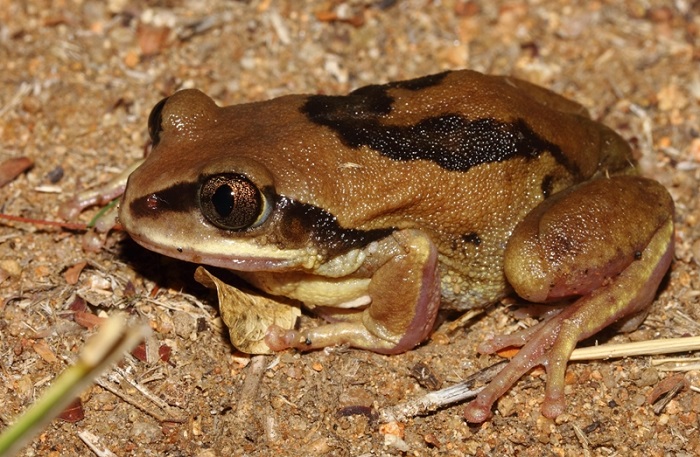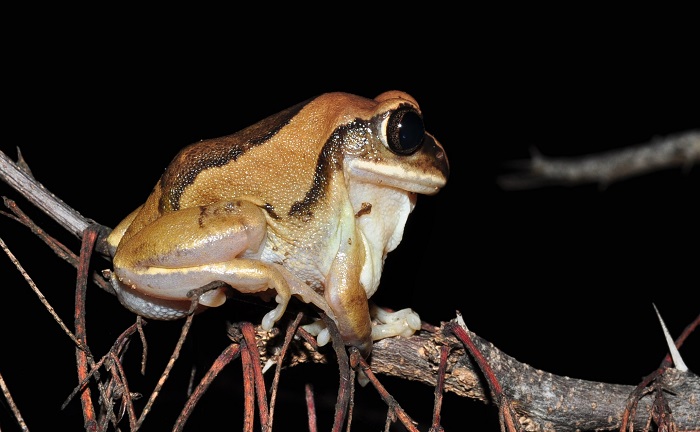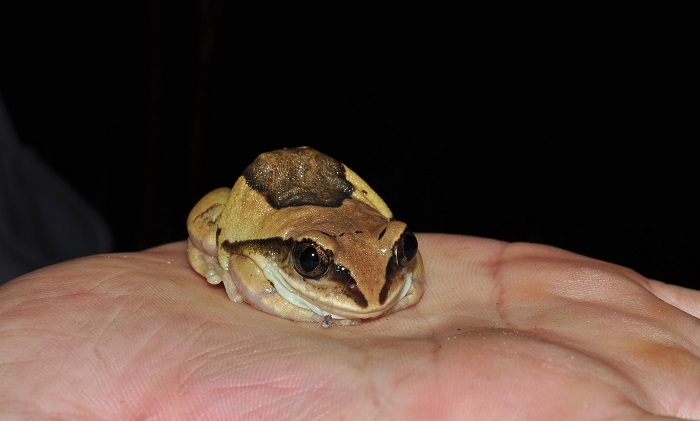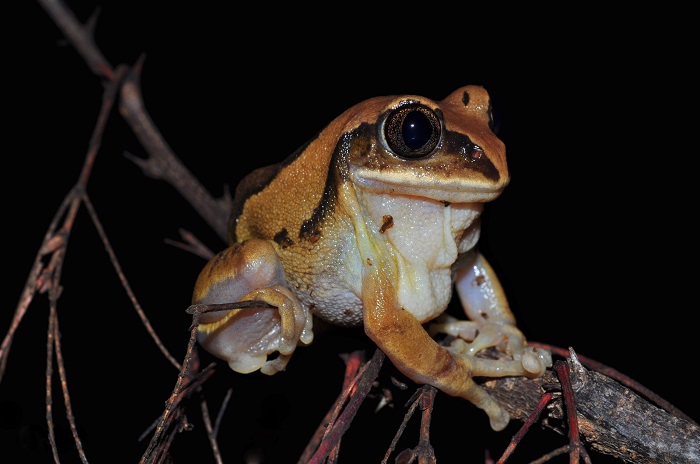Cover photo by Ryan Tippett.
Find the Brown-backed Tree Frog in the FBIS database (Freshwater Biodiversity Information System) here.
Family Heleophrynidae
Identification
The male Brown-backed Tree Frog reaches 52mm, and the female attains 63mm. They are robust frogs with long limbs, a blunt snout, and large protruding eyes. Adults are brown with a prominent blackish horseshoe marking on the back and a dark mask from the snout to the forelimbs.
Subadults are uniformly green and may be mistaken for the Forest Tree Frog (Leptopelis natalensis).

Near Hoedspruit, Limpopo
Photo by Alison Sharp
Habitat
In South Africa, the Brown-backed Tree Frog inhabits a variety of bushveld vegetation types in the Savanna Biome. It is also known to occur in Sand Forest and mangrove swamps. It appears to prefer moist, wooded, low-lying areas where it lays its eggs under leaf litter next to shallow pans, pools, and streams. It has been recorded from relatively high altitudes in southern Malawi to sea level along the KwaZulu-Natal coast.

Photo by Ryan Tippett
Behaviour
The Brown-backed Tree Frog retreats underground during the day and during the dry winter months. Wager (1965) noted that captive individuals spent the dry season (5–6 months) buried in the soil at a depth of 25 cm below the surface.
Breeding begins after the first heavy summer rains in November, and continues through January. Males call from elevated positions on grass, reeds, sedges, shrubs and trees, usually no more than 1.5 m above the ground. These call sites are normally near open water, but may be several hundred metres distant. The males are territorial and produce aggressive calls when other males are in close proximity. If the intruder does not move away, protracted fighting may occur (Passmore and Carruthers 1995).

Hluhluwe District, Kwazulu-Natal
Photo by Ryan Tippett
The eggs are laid in a shallow burrow under leaf litter near the water’s edge (L.R.M. pers. obs.). The tadpoles complete part of their development in the nest, and may remain in a state of arrested development for several weeks until the next heavy downpour. When the egg capsules are moistened by rain, the tadpoles immediately break out and wriggle en masse to the water, where they complete their development (L.R.M. pers. obs.).
In captivity, the Brown-backed Tree Frog consumes beetles, termites, moths, and their larvae, and a record exists of a captive individual eating a baby chameleon (Wager 1986).
Status and Conservation
Within its distribution range, the Brown-backed Tree Frog is fairly widespread and is known to occur in numerous public and private protected areas. Populations appear to be stable. There are no known threats to the Brown-backed Tree Frog at present. The continued protection of this species’ habitat in conservation areas should be sufficient to ensure its long-term survival.

Near Hluhluwe, KwaZulu-Natal
Photo by Ryan Tippett
Distribution
The Brown-backed Tree Frog is distributed from southern Malawi through south-eastern Zimbabwe to central and southern Mozambique (Poynton and Broadley 1987; Lambiris 1989a). In the atlas region, it occurs in the low-lying eastern parts of Limpopo Province, eastern Mpumalanga, Swaziland, and northern KwaZulu-Natal. The southernmost record collected during the atlas survey at Everton (2930DD) and the historical record from Wentworth, Durban (2931CC), are disjunct from the main distribution further to the north. This break in distribution may reflect inadequate sampling.

The colour, markings and call of L. mossambicus are distinctive, and it cannot be mistaken for any other frog species in the atlas region. The atlas data are reliable and reasonably complete.

Hluhluwe District, Kwazulu-Natal
Photo by Ryan Tippett
Further Resources
The use of photographs by Alison Sharp is acknowledged. Other photographs by Ryan Tippett.
Brown-backed Tree Frog Leptopelis mossambicus Poynton, 1985
Other Common Names: Mozambique Tree Frog (Alt. English); Bruinrug-boompadda (Afrikaans).
Recommended citation format: Minter, LR; Theron, J; Tippett, RM. (2025). Brown-backed Tree Frog Leptopelis mossambicus. Biodiversity and Development Institute, Cape Town. Available online at https://thebdi.org/2022/01/11/brown-backed-tree-frog-leptopelis-mossambicus/
This species text has been updated and expanded from the text in the
2004 frog atlas: Minter, LR; Theron, J. (2004). Brown-backed Tree Frog Leptopelis mossambicus. In Minter LR
et al 2004.
References:
Minter, LR; Burger, M; Harrison, JA; Braack, HH; Bishop, PJ; Kloepfer, D. (Editors). (2004). Atlas and Red Data Book of the Frogs of South Africa, Lesotho and Swaziland. Smithsonian Institution, Washington, and Avian Demography
Unit, Cape Town.
Carruthers, V; du Preez, L. (2017). Frogs of southern Africa: A Complete Guide. Struik Nature, Cape Town.
Channing, A. (2001) Amphibians of Central and Southern Africa. Protea Book House, Pretoria
Claus, B; Claus, R. (2002). Common Amphibians and Reptiles of Botswana. Gamsberg Macmillan, Windhoek.

